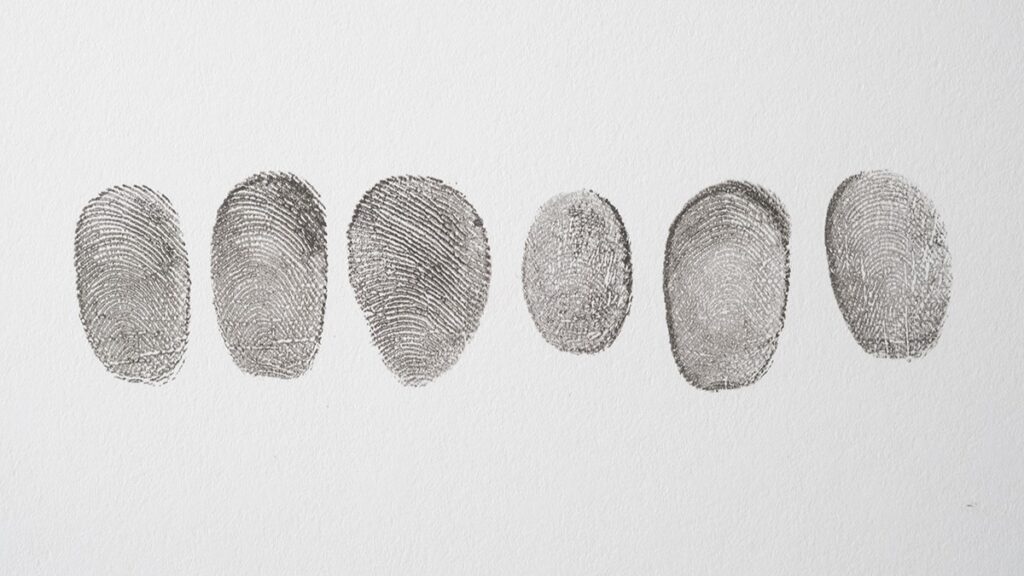Fingerprint Records
Whether for the purpose of identification or prosecution, fingerprints can be a useful and powerful tool for police in criminal proceedings. As such, the Crimes Act 1958 (Vic) (all future references to legislation will refer to this act unless stated otherwise) permits the taking of fingerprints under particular circumstances.

When can fingerprints be taken?
Whether or not a police officer is permitted to take fingerprints under sections 464K, 464L or 464NA will depend on various factors about both the offending (or suspected offending) and the individual themselves. It may be useful to consider the following questions.
Is the Individual an Adult (15+ y/o)?
Section 464K(1) allows a police officer to take, or authorise the taking of, the fingerprints on an individual where they:
- are believed to have committed;
- have been charged with; or
- have been summoned to answer to a charge of –
an indictable offence or a summary offence outlined in Schedule 7.
Alternatively, for the purposes of IDENTIFICATION only, section 464NA(2) permits a police officer to take, or authorise the taking of, a fingerscan of an individual where they:
- have been charged with an indictable offence or a summary offence outlined under Schedule 7; and
- are present in a police station in relation to the charge in question.
The power conveyed under section 464NA(1) differs from that under section 464K, and were appropriate this article will distinguish between the two.
Is the Individual a Child (<15 y/o)?
If the child is under the age of 10, and is suspected of having committed or omitted an act which would otherwise constitute an offence had they been of age, section 464L(1) prevents that child’s fingerprints from being (a) requested from them, or (b) taken entirely.
If the child is at least 10 years old, but still younger than 15 years old, the rules as discussed above (in relation to section 464K apply) with the added requirements in section 464L(2) that either:
- Both the child and a parent/guardian consent to the fingerprint being taken (s 464L(2)(d)); or
- The Children’s Court makes an order that the fingerprint be taken (s 464L(2)(e)).
In order to fingerprint a child aged between 10 and 14 years, the child’s parent or guardian must be present when police request fingerprints, give information to the child and take fingerprints (s 464L(4)). There is no provision for an independent person to be present in the absence of the child’s parent or guardian.
When can fingerprints be taken?
Whether or not a police officer is permitted to take fingerprints under sections 464K, 464L or 464NA will depend on various factors about both the offending (or suspected offending) and the individual themselves. It may be useful to consider the following:
Is the Individual an Adult (15+ y/o)?
Section 464K(1) allows a police officer to take, or authorise the taking of, the fingerprints on an individual where they:
- are believed to have committed;
- have been charged with; or
- have been summoned to answer to a charge of –
an indictable offence or a summary offence outlined in Schedule 7.
Alternatively, for the purposes of IDENTIFICATION only, section 464NA(2) permits a police officer to take, or authorise the taking of, a fingerscan of an individual where they:
- have been charged with an indictable offence or a summary offence outlined under Schedule 7; and
- are present in a police station in relation to the charge in question.
The power conveyed under section 464NA(1) differs from that under section 464K, and were appropriate this article will distinguish between the two.
Is the Individual a Child (<15 y/o)?
If the child is under the age of 10, and is suspected of having committed or omitted an act which would otherwise constitute an offence had they been of age, section 464L(1) prevents that child’s fingerprints from being (a) requested from them, or (b) taken entirely.
If the child is at least 10 years old, but still younger than 15 years old, the rules as discussed above (in relation to section 464K apply) with the added requirements in section 464L(2) that either:
- Both the child and a parent/guardian consent to the fingerprint being taken (s 464L(2)(d)); or
- The Children’s Court makes an order that the fingerprint be taken (s 464L(2)(e)).
In order to fingerprint a child aged between 10 and 14 years, the child’s parent or guardian must be present when police request fingerprints, give information to the child and take fingerprints (s 464L(4)). There is no provision for an independent person to be present in the absence of the child’s parent or guardian.
Fingerprinting Procedure
Section 464N(1) allows for the fingerprints of an individual to be taken by any means, though specific mention is given in the Act to fingerscan devices which are used to obtain a record of the fingerprint.
However, more specific to the process, the Act imposes requirements on a police officer, or those authorised by them, that they INFORM the individual from whom the fingerprints are to be being taken of the process itself, and other specific elements.
Section 464K(2) requires the individual to be informed of:
- the purpose for which their fingerprint is to be taken;
- the offence to which it pertains;
- that it may be used as evidence in court (unless taken under section 464NA(2), wherein they must be informed, pursuant to subsection (3), that (a) its only purpose it the individual’s identification, and that (b) it as such is inadmissible in court);
- that reasonable force may be used, should the individual not give their fingerprints voluntarily; and
- that, after a period of 6 months, if the individual has not been charged, found guilty, or had their charge proceed in any way, their fingerprints will be destroyed.
As it relates to children (10-15 y/o), section 464L(3) details that much the same information as outlined in section 464K(2) be provided to both the child and their parent/guardian, with the following distinctions:
- Since reasonable force cannot be used, it will not be detailed; and
- The child and their parent/guardian must be informed that they can refuse to have the fingerprint’s taken, and that, should they do this, an application may be made to the Children’s Court under section 464M to require the taking of fingerprints.
Where the individual is under the age of 18 (i.e., a child no younger than 10 years old but not yet 15 years old (section 464L (4)), or an individual 15, 16, or 17 years old (section 464K(8)(a)), the Act requires their parent/guardian, or an independent person, be present for the fingerprint request, provision of information, and taking of the fingerprint.
Additionally, both section 464K and 464L impose obligations that require a police officer taking an individual’s fingerprints to record, whether via audio-visual means or in writing, the interaction in which the information was conveyed.
In exercising their power to take fingerprints, police officers are also permitted to use REASONABLE FORCE in specific circumstances.
Section 464K(7) (as well as section 464NA(4)) permits the use of reasonable force on an individual who refuses to give their fingerprints voluntarily, though its use must be authorised.
Should the individual be aged 15, 16, or 17 years old, the use of reasonable force must be recorded by audio-visual means (section 464K8(b)).
Where reasonable force is to be used, or a court order enforced, section 464N(2) requires that, if practicable, the fingerprint not be taken by a police officer involved in investigating the offence and that it be taken by someone of the same sex as the person to be fingerprinted.
In the case of children covered by section 464L, the requirement of consent dissolves the ability of a police officer to use reasonable force to obtain the fingerprint, and as such section 464L makes no mention and does not permit a police officer to use such force.
When Must a Fingerprint Record be Destroyed?
Section 464O(2) requires that, other than in particular circumstances, any fingerprints taken under any section discussed above must eventually be destroyed. When a fingerprint is required to be destroyed will depend on the particular circumstances at play.
- If no charges have been laid, or charges so laid have not been proceeded with, the fingerprint must be destroyed within 6 months of it being taken (subsection (2)(a) and (3)(b))); or
- If the individual was found not guilty, whether on appeal or otherwise, the fingerprint must be destroyed within 1 month of the conclusion of the proceedings (subsection (2)(b) and (3)(b)).
Subsection (1) details that to destroy a fingerprint means to de-identify it from the specific individual.
Lastly, though the fingerprint is required to be destroyed after the set period described above, before the close of that period a police officer may apply under subsection (4) that the period be extended by a period no greater than 6 months.


